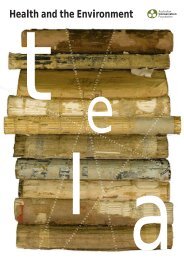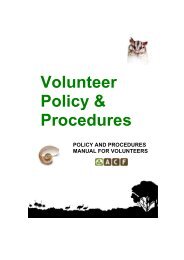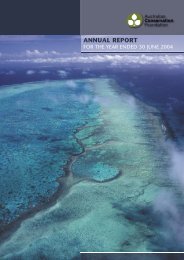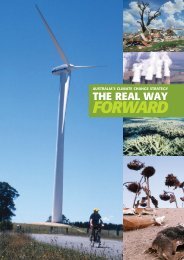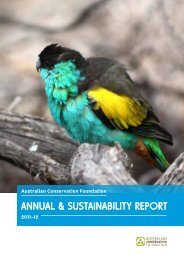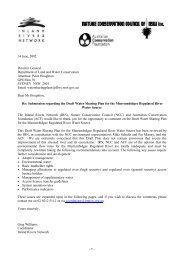Protecting Western Australia's Big Blue Backyard - The Pew ...
Protecting Western Australia's Big Blue Backyard - The Pew ...
Protecting Western Australia's Big Blue Backyard - The Pew ...
- No tags were found...
You also want an ePaper? Increase the reach of your titles
YUMPU automatically turns print PDFs into web optimized ePapers that Google loves.
In supporting an endto whaling, <strong>Western</strong>Australians made a majorcontribution to the causeof protecting the world’smarine life taking refugein their watersCOOLER AND STORMIER WATERS WITHGRANITE REEFS<strong>The</strong> turbulent mixing of water at Cape Leeuwinsaps the Leeuwin Current of some of its energyas it turns to head east along the south coast.From here it leaves behind the limestone coastand flows into the stormier waters of the southcoast and a very different marine environment.Along the region’s south coast there is littleprotection from fierce southerly swells and inshorelagoons are absent. <strong>The</strong> Leeuwin Current is alsoin competition with the cooler Flinders Currentfrom the east carrying the larvae and fish eggsof cool-water species.<strong>The</strong> south coast’s cliffs and reefs are carved fromhard granite, a rock that erodes very slowly,even on coastlines like this where the energy ofthe waves can be felt at a depth of 100 metres.With little erosion, the reefs here have far fewermicrohabitats than the west coast’s myriadof caves and crevices etched in soft limestone.As a result, there are lower numbers of bottomdwellingspecies such as crabs and rock lobsters.Kelp beds and sponge communities cover thesouth coast’s reefs which are generally in deeperwater than those of the west coast. <strong>The</strong> clearwaters allow light to penetrate deeply and kelpto grow at depths of up to 120 metres.Leafy and weedy seadragons gently hover amongthe swaying kelp blades. <strong>The</strong>se beautiful andfragile creatures are only found in Australia’ssouthern waters and are threatened by harvestingfor the aquarium trade and as accidental catch infishing nets.In these cooler south-coast waters the compositionof marine species changes. <strong>Western</strong> rock lobsterare replaced by the southern rock lobster, and theWest Australian dhufish and baldchin groper giveway to mulloway, harlequin cod and bight redfish.Greenlip abalone, not found on the west coast,occurs here in relatively large numbers.Compared with the limestone coast of the west,there is a greater proportion of bottom-dwellingfinfish relative to crustaceans. Surface-dwellingfish numbers are higher on the south coast’scontinental slope.<strong>The</strong> creation of large no-take marine reserves canensure the protection of the various habitats foundalong the west and south coasts, in offshore andnearshore waters and on the sea floor.CANYON COUNTRY, WHALES ANDORANGE ROUGHYNear Albany the Leeuwin Current encounterswhat the locals call the Albany Hills, even thoughthere is nothing small about the Albany Canyons.Here 32 canyons spread along 700 kilometres ofthe continental slope from Albany to the east ofEsperance. Offshore eddies and upwellings spurplankton production and feeding frenzies by smalland large surface-dwelling fish.Deep sea orange roughy gather in the AlbanyCanyons to spawn, possibly along with bluegrenadier and gemfish. Until 2005, commercialfishers were allowed to target the orange roughy,but by 2007 only bycatch was permitted, set at fiveper cent of previous allowable catches. Here andthroughout Australia the stocks of orange roughyhave been overfished and their deep sea habitatsseverely damaged by bottom trawling. <strong>The</strong> speciesis now listed as ‘of conservation concern’ underfederal environmental law.Every summer the southern right whales of<strong>Western</strong> Australia go to the sub-Antarctic tofeed. In winter they return to calve in the LeeuwinCurrent’s warm waters between the AlbanyCanyons and the coast. <strong>The</strong> sheltered PrincessRoyal Harbour at Albany is a favoured location forthese rare whales, much to the delight of whalewatchers and whale tour operators.Only a few hundred southern right whales livealong the Australian coast. <strong>The</strong>y are still recoveringfrom the days of commercial whaling when 26,000were killed in Australian and New Zealand watersbefore whaling was banned.Sperm whales are also known from the canyonsof this area where they might swoop down theslope in pursuit of a giant squid. In 1978 two giantsquid were found in the stomach of a sperm whalecaught in the final days of the Cheynes BeachWhaling Company station at Albany. Sperm whaleshad become the target of the station after whalingfor humpbacks was banned in 1963.On 20 November 1978, the company caughta sperm whale that was to be the last whale tobe killed in Australian waters. <strong>The</strong> next day thestation, the last in Australia, closed. In April of1979 the Australian Government bannedcommercial whaling in Australian waters.In supporting an end to whaling, <strong>Western</strong>Australians made a major contribution to thecause of protecting the world’s marine life takingrefuge in their waters. Since then Australia hasbecome a global champion for whales. And theban on whaling is now reaping huge rewards backhome with the rapidly growing whale-watchingindustry fuelling jobs and tourism in <strong>Western</strong>Australia and beyond. <strong>Protecting</strong> marine life canprovide long-term economic benefits and is furtherreason to establish a CAR network of large no-takemarine reserves in the Kalbarri to Eucla region.Deep-diving sperm whales wereharvested in Australian watersuntil 1978 when the Albanywhaling station – the last inAustralia – was closed© marinethemes.com / Tony Wu51



